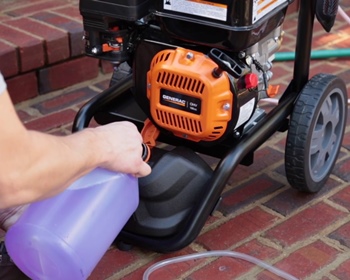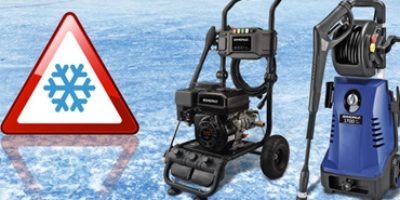When it comes to pressure washers, it might be tempting to store them without conducting any maintenance on them. However, if you want to reap the most out of your unit, you will have to conduct proper maintenance on it. Failing to do so may lead to the loss of your warranty – and causing you to pay more on repairs than you were supposed to.
Maintenance will also keep the unit performing properly throughout hundreds of hours of use – which is why it is a step that should not be skipped. If you want to learn how to conduct proper maintenance on your pressure washing unit, this is a guide that will help you out.
Proper Preparation for Pressure Washer Maintenance
 When it comes to maintenance, it is usually the gasoline models that require the most attention. Electric pressure washers need the same maintenance steps as those in the gas units – still, the difference is that gas units need some extra attention to the oil and fuel part. Portable power washers might also require less maintenance – so, if you want less trouble, you should check into small pressure washer buying guides as well.
When it comes to maintenance, it is usually the gasoline models that require the most attention. Electric pressure washers need the same maintenance steps as those in the gas units – still, the difference is that gas units need some extra attention to the oil and fuel part. Portable power washers might also require less maintenance – so, if you want less trouble, you should check into small pressure washer buying guides as well.
Some maintenance steps will require that you keep the pressure washer running, whereas others will require that you keep it off for safety purposes. Ideally, you may want to check the unit’s user manual to determine how proper maintenance should be conducted.
One thing to remember is that you should never operate or conduct maintenance on a gas-powered pressure unit in a space that lacks proper ventilation. Moreover, when operating an electric unit, keep the connections dry and away from the ground. If your hands are wet, do not touch the plug under any circumstances.
When replacing any components that have been damaged, you should also use replacement parts that have been approved by the manufacturer.
Before Using the Pressure Washer
Certain maintenance steps need to be done before actually plugging the unit in. Here are the steps that you should follow to ensure that your cleaning spree runs smoothly.
1. Check the O-Rings
Before turning the unit on, you should check the O-rings of your pressure washer hose for any signs of wear and tear. A damaged O-ring can cause serious issues, including leaks and injuries while you are using the unit. If you see that it is damaged, promptly replace it before you use the unit.
2. Check the Nozzle
The nozzle may sometimes lockout of its place. So, to ensure your safety while you are using the unit, make sure that it is securely locked in. To learn more about different types of nozzles for various units, you might want to visit our home page.
3. Check for Debris
Dirt and debris can clog your unit and cause it to lose pressure. To prevent any faults, make sure that there is no dirt, debris, or anything else stuck into the nozzle.
4. Replace the Gas and Oil
When using a pressure washer for the first time after a long period, make sure to replace both the gas and oil of the unit. If your pressure washer still has gas from the last season, you might want to add some stabilizer – and after that, top everything off with fresh gasoline.
5. Check the Spark Plug
Before turning the unit on, check the spark plug for any signs of corrosion. If the spark plug has corroded, it might not only cause difficulty when you are starting it – but it might also cause inefficiency while it is used. If the spark plug has corroded, make sure that you replace it.
When you are running the unit, make sure that you keep the spray nozzle open. If you run the unit, but the nozzle is closed, then it might cause damage to your unit as it will build up pressure in the hose. Moreover, keeping a healthy supply of water is a crucial step in its maintenance, as its absence will cause the pressure to increase too much.
Maintenance After Using the Pressure Washer
Once you have used the pressure washer, there are a few steps that you might want to follow if you want to ensure its functionality afterward.
1. Rinse the Detergent
After using the pressure washer, the first step in its maintenance is to ensure that you rinse the detergent from it. Take the siphoning tube away from the detergent supply, and then set the pressure to low. Add the siphoning tube in a bucket of clear water and run the unit for about two minutes.
2. Relieve the Pressure
Turn the pressure washer off, as well as the water supply. If the unit you are using is electrical, then you should also unplug it. Take the spray gun and point it away from objects, people, and animals – and then run it until there is no more water flowing. After this, you should press the trigger lock and allow the unit to cool down.
3. Disconnect and Drain Everything
Disconnect the garden hose from the pressure washer, the spray gun, the high-pressure hose, and the wand extension. Drain any remaining water from them. Remove any remaining water from the pump as well, by pulling the recoil handle a couple of times. You might also want to treat the pump with antifreeze if you are planning to store it throughout the winter.
4. Treat or Drain the Fuel
Before storing the unit, treat the remaining gasoline with a stabilizer so that it does not clog into the engine. If you do not want to leave it in the pressure washer, you should drain the gasoline and add it into an approved container. Run the pressure washer again until the engine completely stops from lack of gasoline. Store it into a dry area until the new season comes.
Final Thoughts
Pressure washers are very useful to have around – but if you want to reap the benefits of using them, you will have to maintain them properly. Follow the instructions provided by the manufacturer, and this way, you’ll ensure not only your safety but also the safety of those around you.
Generally speaking, if a part of a pressure washer shows any signs of wear and tear, you should have that piece replaced immediately. If it is under warranty, you may take it into the shop to have those pieces replaced.

